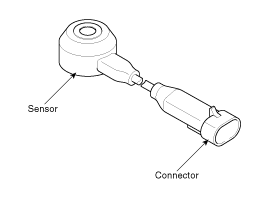 Hyundai Santa Fe: Knock Sensor (KS). Description and Operation
Hyundai Santa Fe: Knock Sensor (KS). Description and Operation
Description
Knocking is a phenomenon characterized by undesirable vibration and noise
and can cause engine damage. Knock Sensor (KS) is installed on the cylinder
block and senses engine knocking.
When knocking occurs, the vibration from the cylinder block is applied
as pressure to the piezoelectric element. When a knock occurs, the sensor produces
voltage signal. The ECM retards the ignition timing when knocking occurs. If
the knocking disappears after retarding the ignition timing, the ECM will advance
the ignition timing. This sequential control can improve engine power, torque
and fuel economy.

 Camshaft Position Sensor (CMPS). Repair procedures
Camshaft Position Sensor (CMPS). Repair procedures
Inspection 1. Check the signal waveform of the CMPS and CKPS using the GDS. Specification: Refer to “Wave Form” Removal • DON’T remove the camshaft position sensor while the engine is running or ...
 Knock Sensor (KS). Specifications
Knock Sensor (KS). Specifications
Specification Item Specification Capacitance (pF) 850 ~ 1,150 ...
See also:
Room Lamp. Repair procedures
Inspection 1. Remove the room lamp assembly then check for continuity between terminals. [General] [Panorama Sunroof] Removal 1. Disconnect the negative (-) battery terminal. 2. Detach the lamp lens (A) ...
Water pump. Components and Components Location
Components 1. Water pump pulley 2. Water pump 3. Water pump gasket 4. Water pump housing 5. Water pump housing gasket 6. O-ring 7. Water inlet pipe ...
Engine Coolant Temperature Sensor (ECTS). Description and Operation
Description Engine Coolant Temperature Sensor (ECTS) is located in the engine coolant passage of the cylinder head for detecting the engine coolant temperature. The ECTS uses a thermistor that changes ...
